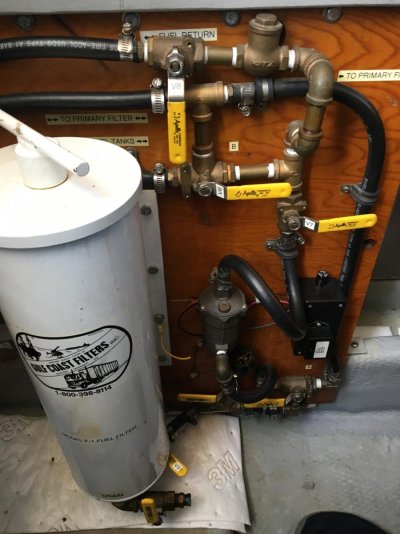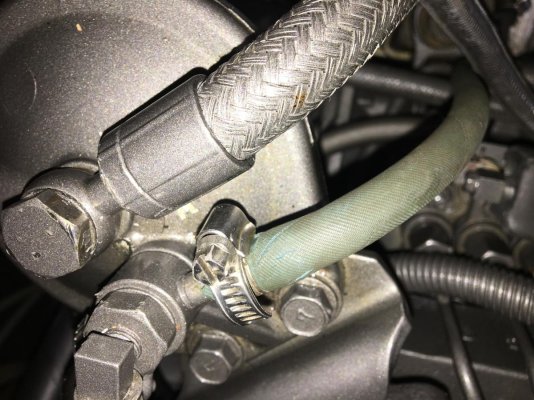Djoub
Veteran Member
Sorry for the long post but I am hoping for some good info regarding fuel problems.
Boat is a 1998 Mainship 35 with a single 2008 Yanmar 370 hp bought less the a year ago. Original engine may have been gas. Engine has stopped a couple of times, once leaving me stranded on the water, second time was in slip. First time I thought it was dirty filters so all filters changed and bled system, everything worked for a couple of weeks. Second time no fuel to primary and secondary filters. Hired a mechanic and said I lost fuel to racor input, he primed everything and it ran good. A day later while looking around the engine room while it was running, I noticed air bubbles in the glass bowl at bottom. When I went to refill the racor, the fuel kept being slowly sucked down. I’m guessing it was leveling to the level of fuel in the tanks. It would only stop drawing when I shut off both supply values on the two tanks. I have a home made fuel polisher with a Gulf Coast Filter and a electric fuel pump, all by-passed for now with shutoff valves. A couple of weeks ago I moved fuel from one tank to another, don’t remember how I left the valves but the next day both tanks were back to equal. Is this normal or do I need to close tank valves when engine is not running?
So I have 3 issues:
1) Bubbles in fuel stream while engine is running
2) Fuel flowing back into tank(s) with supply valve open
3) Small fuel leak somewhere in Port side tank area that can’t be found.
Are all three problems related? I can’t find any leaking using the paper towel method but I end up with a small amount near the stringer the tank sits on. All the fittings and clamps seem dry but as I said small leak somewhere near tank.
Someone mentioned could be a bad anti-siphon barb fitting on fuel tanks? Thinking of installing a temporary squeeze bulb on a short new hose from input of the racor, to a container of fuel or straight into one of the tanks and bypassing all the fittings and working back thru the system looking for bubbles.
Any thoughts on trouble shooting or ideas? I’m starting to think I should trade it in for a canoe Thanks
Thanks
Boat is a 1998 Mainship 35 with a single 2008 Yanmar 370 hp bought less the a year ago. Original engine may have been gas. Engine has stopped a couple of times, once leaving me stranded on the water, second time was in slip. First time I thought it was dirty filters so all filters changed and bled system, everything worked for a couple of weeks. Second time no fuel to primary and secondary filters. Hired a mechanic and said I lost fuel to racor input, he primed everything and it ran good. A day later while looking around the engine room while it was running, I noticed air bubbles in the glass bowl at bottom. When I went to refill the racor, the fuel kept being slowly sucked down. I’m guessing it was leveling to the level of fuel in the tanks. It would only stop drawing when I shut off both supply values on the two tanks. I have a home made fuel polisher with a Gulf Coast Filter and a electric fuel pump, all by-passed for now with shutoff valves. A couple of weeks ago I moved fuel from one tank to another, don’t remember how I left the valves but the next day both tanks were back to equal. Is this normal or do I need to close tank valves when engine is not running?
So I have 3 issues:
1) Bubbles in fuel stream while engine is running
2) Fuel flowing back into tank(s) with supply valve open
3) Small fuel leak somewhere in Port side tank area that can’t be found.
Are all three problems related? I can’t find any leaking using the paper towel method but I end up with a small amount near the stringer the tank sits on. All the fittings and clamps seem dry but as I said small leak somewhere near tank.
Someone mentioned could be a bad anti-siphon barb fitting on fuel tanks? Thinking of installing a temporary squeeze bulb on a short new hose from input of the racor, to a container of fuel or straight into one of the tanks and bypassing all the fittings and working back thru the system looking for bubbles.
Any thoughts on trouble shooting or ideas? I’m starting to think I should trade it in for a canoe


